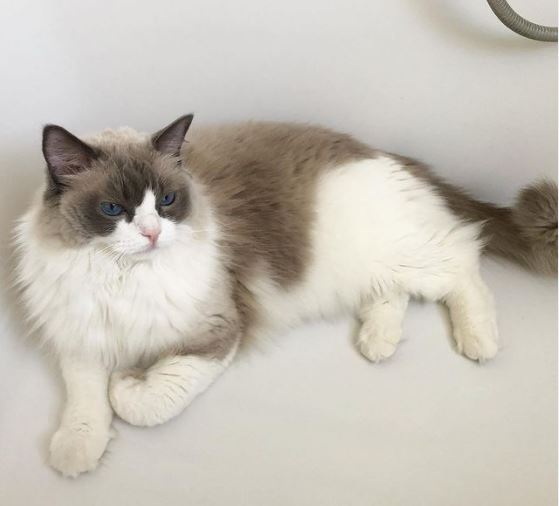Yes, having two Ragdoll cats can improve their social skills, provide companionship, and prevent boredom. Consider adoption, finances, and space before adding another cat. Introduce a new cat with patience and separate spaces. Monitor interactions closely to guarantee harmony.
Ragdolls enjoy playtime and build strong bonds. Recognize signs of needing a companion like loneliness or behavior changes. To maintain harmony in a multi-cat household, understand individual personalities, maintain routines, and provide enough resources.
Additional insights on integrating Ragdoll cats can help optimize their well-being and happiness.
Benefits of Having Two Ragdoll Cats
Having two Ragdoll cats can enhance their socialization skills and provide companionship for each other. They become playtime buddies, engaging in interactive sessions that stimulate their minds and bodies.
The presence of a feline friend can encourage exercise and prevent boredom, leading to a healthier lifestyle for both cats. Additionally, Ragdolls are known for their affectionate nature, making them excellent cuddle companions for each other.
Through grooming sessions and cozy naps together, these cats can form strong bonds that fulfill their social needs. Overall, having two Ragdoll cats not only enriches their lives but also creates a harmonious environment where they can thrive and grow happily together.
Considerations Before Getting Another Cat
Before deciding to add another cat to our home, it’s important to contemplate several key factors to guarantee a seamless change and peak well-being for all feline residents.
To begin with, the adoption process and compatibility assessment are essential. Ensuring that the new cat will get along with current residents is crucial for a harmonious environment.
Additionally, consider the financial implications and space considerations. Adding another cat means additional expenses for food, litter, veterinary care, and toys.
Furthermore, assess if there’s enough space in your home for multiple cats to have their territories and personal areas.
Careful evaluation of these factors will help in making an informed decision that benefits both the new cat and existing feline companions.

Introducing a New Ragdoll Companion
When adding a new Ragdoll companion to our family, it’s essential to approach the introduction process with patience and careful planning. The bonding process between a solo cat and a new companion requires thoughtful integration strategies to guarantee a smooth shift.
Start by creating separate spaces for each cat, allowing them to get accustomed to each other’s scent before any direct interaction. Supervised meetings in a neutral area can help gauge their initial reactions and prevent potential conflicts. Gradually increase the time they spend together while monitoring their interactions closely.
Providing each cat with their resources like food, water, and litter boxes can reduce competition and promote a harmonious relationship between the feline companions.
Bonding Dynamics Between Ragdoll Cats
Let’s talk about how Ragdoll cats interact with each other.
They’ve fascinating social behavior, from grooming sessions to playtime antics.
Understanding how they establish hierarchy and the dynamics between siblings versus non-siblings can help us create a harmonious environment for our feline companions.
Ragdolls’ Social Behavior
Ragdoll cats are known for their gentle and affectionate nature, which plays a significant role in their bonding dynamics with other Ragdoll cats. When it comes to playmate dynamics, Ragdolls often enjoy engaging in interactive play sessions with their feline companions, fostering a sense of companionship and fun.
This type of social interaction not only provides entertainment but also helps in building strong bonds between Ragdoll cats. Additionally, the socialization benefits of having another Ragdoll cat around include reduced feelings of loneliness and increased opportunities for shared activities.
Ragdolls thrive in a social environment where they can interact with another cat, enhancing their overall well-being and happiness through companionship and play.
Establishing Cat Hierarchy
Establishing a cat hierarchy within a group of Ragdoll cats involves observing their interactions and behaviors to understand how they establish bonds and social dynamics. Cat relationships and dominance play vital roles in determining the hierarchy among feline companions.
Through behaviors like grooming, playing, or even subtle body language cues, Ragdoll cats establish their place within the group. Dominance can be displayed through confident postures, vocalizations, or even minor scuffles to assert rank.
Understanding these dynamics is essential for ensuring a harmonious environment among Ragdoll cats. By recognizing and respecting the hierarchy, owners can facilitate smoother interactions and promote feline companionship. Maintaining a balanced hierarchy helps prevent conflicts and fosters a peaceful coexistence among Ragdoll cats.

Sibling Vs. Non-Sibling Dynamics
When considering the bonding dynamics between Ragdoll cats, it’s important to distinguish between sibling and non-sibling relationships. Sibling Ragdoll cats, whether from the same litter or adopted together, often have a strong bond due to their shared history. This bond can lead to smoother integration into a new home and fewer territorial issues.
On the other hand, non-sibling Ragdolls, whether from adoption or a breeder, may take longer to establish their relationship. Introducing Ragdolls with significant age differences can also impact their dynamics. Younger cats may look up to older ones for guidance, while older cats might need time to adjust to a playful new companion.
Understanding these dynamics can help create a harmonious environment for Ragdoll cats in a multi-cat household.
Signs Your Ragdoll Needs a Companion
If you notice your Ragdoll becoming increasingly lonely or exhibiting more clingy behavior than usual, it may be a sign that they could benefit from having a companion.
Here are some signs that your Ragdoll may need a companion:
- Solo Ragdoll? Is your Ragdoll spending more time hiding or avoiding interaction?
- Changes in Behavior: Have you noticed an increase in vocalization, destructive behavior, or excessive grooming?
- Seeking Constant Attention: Is your Ragdoll demanding attention more frequently or displaying neediness?
Recognizing these signs can help you determine if your Ragdoll would benefit from the company of a companion cat. It’s essential to consider your Ragdoll’s well-being and happiness when deciding whether to introduce another cat into their life.
Tips for Multi-Ragdoll Household Harmony
In a multi-ragdoll household, maintaining harmony among the cats requires understanding their personalities and providing adequate resources for each feline. Ensuring consistent playtime routines and feeding schedules can help alleviate tension and promote a peaceful coexistence.
By engaging in interactive play sessions with each cat, we create opportunities for exercise and mental stimulation, reducing the likelihood of conflicts. Additionally, establishing structured feeding schedules can prevent competition for food and minimize food-related aggression. It’s essential to monitor each Ragdoll’s behavior during these activities to tailor the routines to their preferences.
Below is a table outlining a sample schedule for playtime and feeding to assist in fostering a harmonious environment:
| Time | Activity |
|---|---|
| 9:00 AM | Playtime |
| 12:00 PM | Feeding |
| 3:00 PM | Playtime |
| 6:00 PM | Feeding |
| 8:00 PM | Playtime |
Frequently Asked Questions
Can Ragdoll Cats Be Left Alone for Long Periods?
Yes, Ragdolls can be left alone for long periods, but they thrive with companionship. Their independence varies, but having another cat can positively impact their behavior. It’s crucial to take into account their need for interaction.
How Do Ragdolls Behave With Other Pet Species?
Surprisingly, Ragdolls have unique relationships with other pets. They may form unlikely bonds with dogs and birds, showcasing their adaptable and friendly nature. Ragdoll cat friendships often defy stereotypes, creating heartwarming interspecies connections.
Will Getting Another Cat Affect My Ragdoll’s Health?
Introducing a companion can enhance social interaction for Ragdolls, but it’s important to monitor behavioral changes. Consider Ragdoll’s health implications, such as stress levels and potential conflicts. Vet guidance guarantees a smooth shift for your feline friends.
Do Ragdoll Cats From the Same Litter Get Along Better?
Living with two Ragdoll cats from the same litter can be a double dose of cuteness, but sibling rivalry dynamics are real. Personality differences can lead to conflicts. It’s like having two siblings – love mixed with occasional squabbles.
Can Ragdolls Form Strong Bonds With Non-Ragdoll Cats?
We believe ragdolls can form strong bonds with non-ragdoll cats. Interspecies friendships can be wonderful, but socialization challenges may arise. With patience and proper introductions, cats of different breeds can develop deep and lasting relationships.
Conclusion
To sum up, having two Ragdoll cats can bring double the joy and companionship into your home.
With proper introductions and bonding dynamics, these beautiful felines can thrive in a multi-cat household.
Remember, two is better than one when it comes to Ragdolls – they’ll keep each other entertained and provide endless entertainment for you.
So why settle for one when you can have a dynamic duo of fluffy love?

Hey guys, My name is Simon Smith. I’m from Canada and live near Victoria
I live with my sweet family and have 20+ Ragdolls of different types. I love them as my children. My profession is as a hotel manager.
I love to keep Ragdolls and grow their breeder case. I have 7 years of experience.
I’m an expert in cat care. So, I’m here to provide you with new information about my cats daily. This is my blog website, so I request that you kindly visit our site daily.
If you’re a Ragdolls lover and you have any questions or confusion about cats, text me on the Contact Us page or Gmail.
Thank u
